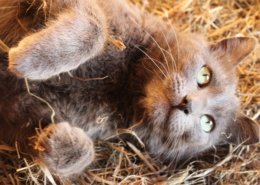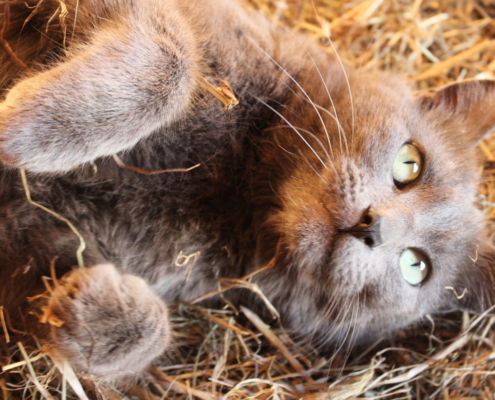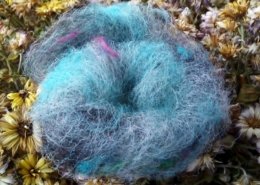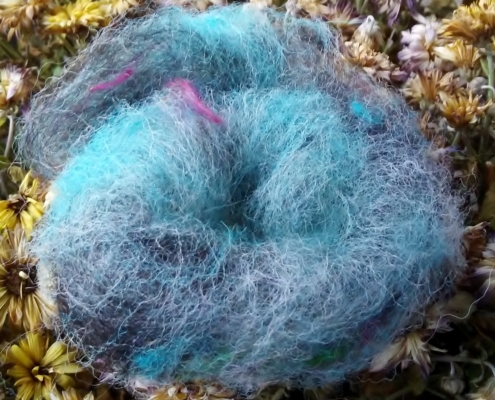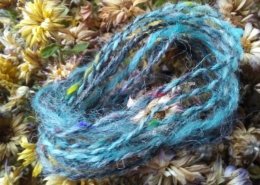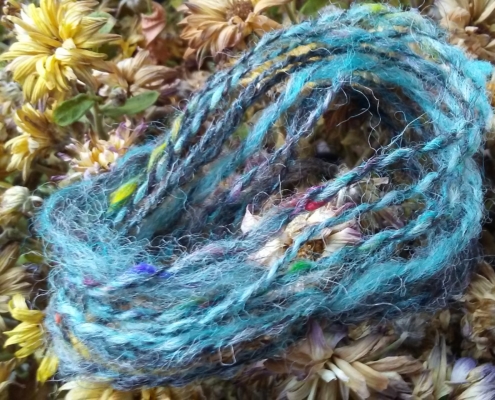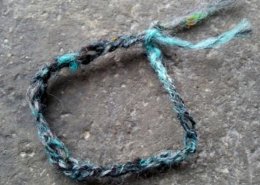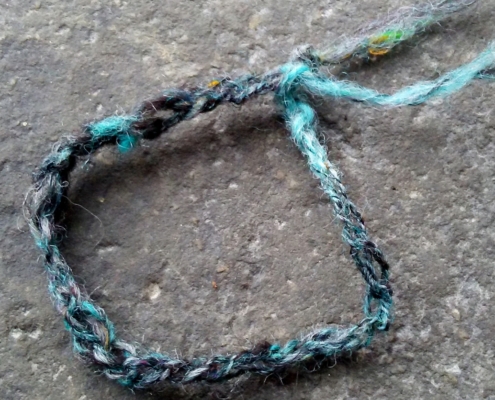How to Make the Best of It: Commemorative Skeins for a Beloved Pet
words by Jacqueline Harp (photos by Jacob Harp)
No one wants to think about a time when a beloved companion may not be there to greet you with unconditional love and unchanging affection each and every day. For some, that day has already arrived as they mourn the passing of that dear pet. Others are fortunate to still have that pet with them. Either way, you have an opportunity to use your spinning skills and creativity to capture wonderful memories of your furry or feathery friend by making a mini-skein from fibers collected from your pet. Although it may be challenging to gather fibers from a pet who has already passed, you might be able to find some fiber or fur to work with – you only need a small amount. If your pet is still with you, make an effort now to collect fibers for a future project.
Identify the Fiber
Before you start spinning, take a look at the characteristics of your pet’s fiber, especially if you collect it from a brush or comb. The handle and length of those fibers are going to be the biggest factors to take into consideration in planning, as that will determine how you prep and spin as well as how the final skein will look.
The handle refers to how soft or coarse your fiber feels. Soft, fluffy, downy fibers are easier to draft, require less twist when spun, and are going to give you a softer yarn. Coarse, hairy fibers will need a lot more twist, and the resulting yarn will be coarse.
If you have fibers 3 inches or longer, such as in the case of many long-haired cats, dogs, rabbits, or guinea pigs, the spinning process is going to be similar to spinning typical fibers such as wool or alpaca. The longer the fiber, the easier it is to prepare and spin.
If you have fibers under 3 inches in length, from a pet such as a Jack Russell Terrier, short-haired cat, ferret, or hamster, the spinning process is similar to spinning short-stapled cotton fiber, which can be harder to prepare and spin. You will probably need a lot of twist, and your yarn will turn out hairy and coarse. Keep in mind that you’re a creating a memento, so to describe it as “hairy and coarse” is not a bad thing – it’s simply a description of the yarn characteristics.
If the fibers are very, very short, you may have to blend them with some other spinning fiber. Blending traps these super-short fibers; otherwise, they would be un-spinable. Blending can be done with hand carders, a blending board, or any other tool you would use to blend typical fibers.
Tips for Collection & Storage
Whether you brush, clip, trim, shear, or pick up your pet’s fibers, put the fibers in a brown paper bag, cardboard box, or pillowcase. These options allow the fibers to breathe and are great for storage. Although it may be tempting to use a plastic bag, plastic can cause a buildup of moisture and a risk of felting. Remember that pet fibers are protein fibers, just like wool or alpaca. As such, pet fibers are not safe from pests such as wool moths or mice. Take care to pest-proof the area where you store pet fibers.
Try to collect at least 1–2 ounces of fiber. That way, you will have plenty to work with, even for a small skein. Label and date your fibers as a reference. You don’t want to lose it in your stash.
To Wash or Not to Wash? That is the Question…
The decision to wash pet fibers prior to spinning is up to each handspinner’s personal preference. I have had the most success in spinning pet fibers raw, not washed, even if it means my fingers get dirty while spinning. Washing pet fibers risks felting and the loss of the precious few fibers you may have. Usually, you can gently wash a completed skein of pet fibers during the finishing process.
Whether you decide to spin raw or washed fibers, you can blend your fibers to achieve different effects. It’s a chance to be creative. You can add softness or strength. You can enrich the depth of color of your pet fiber by blending it with a complementary natural color or go all-out with a rainbow of dyed fibers. It is also a great time to add sparkle by integrating Firestar or Angelina into your blend.
Spinning Tips
Once you are ready to spin your pet fiber, you can use one of 3 methods:
1) Spin your pet fibers straight from a small bundle, which is great for short fibers.
2) Spin lock-to-lock or from the fold, which is great for long fibers.
3) Spin straight from hand cards, or take the fiber off the hand cards and make rolags.
Although you can leave your yarn as a singles yarn, you may want to consider spinning at least a 2-ply yarn if the yarn breaks too easily or sheds too much. A 2-ply yarn adds strength and helps mitigate shedding.
Every spinner’s pet fiber is going to spin differently, even among animals of the same breed. Take your time. The goal is to get your fibers to lock together and stay in one piece so you can generate a solid mini-skein.
Fibers collected by brushing are easier to spin than fibers collected by trimming and shearing. Work with what you have, bearing in mind that making this skein is part of a journey which combines old memories and new. Don’t let the small amount or imperfections of your fibers keep you from taking the first step.
Special Cases
Not every pet is typical, but that just adds to the spinning adventure! Let’s look at a few more pet friends whose fibers could be used in creative ways.
Horse hair typically comes in long strands from the mane, the tail, or the feathering found on the lower legs of some horse breeds. You can sandwich single strands of horse hair into a yarn you are plying. You can auto-wrap a horse hair around a single of your choice. If you have enough fiber, you can spin a skein made completely of horse hair.
Feathers have a whole history of being integrated into yarn, as addressed in Judith MacKenzie’s The Intentional Spinner (Interweave Press, 2009). She points out that whether you use whole feathers or strip the feathers from the quill, the result can be beautiful and sturdy. In terms of technique:
Feathers can be encased by placing them by hand between the threads as they spin together. […] You can use them alone or in combination with singles. [You can ply and] Place the feathers between the two yarns at intervals. Then cable two or three of these yarns together (97).
For pets that don’t produce a spinable fiber (such as reptiles, amphibians, ichthyoids (fish), and arachnids), don’t fret. You can find rovings or other prepared fibers in a special color theme to represent that pet. By using your pet as the inspiration for choosing color combinations and fiber type, the possibilities are endless. And if you are not sure, you can always send a picture of your pet to an indie fiber dyer who takes commissions so they can create a roving in a colorway unique to your pet.
Mini Skein Project Suggestions
Once you have produced a mini skein, you can make a special memento out of it in many ways, such as:
1) Knit, weave, or crochet your skein into a precious swatch or bracelet, or leave your yarn as a skein; either way, you can find the perfect frame to display it. You can even include a picture of your pet as a finishing touch.
2) Capture the skein with epoxy resin. Epoxy resin starts as a clear liquid which hardens and cures when exposed to the appropriate temperature. The molds for resin are varied, ranging from jewelry to the classic oval paperweight. Once you have decided on a mold (e.g., a bracelet or pendant), you can add your pet fiber yarn to the resin. After the curing process, your mini skein will be permanently preserved.
The Journey Continues
Now that you have created this commemorative skein, don’t lose it in a storage box or kitchen drawer. Place it in a high-impact location, where you will see it often, and it will warm your heart with memories of that special friend. A project like this adds a lovely dimension to your handspinning achievements. Not only will you learn a whole new aspect of spinning fibers, you will also enrich your fiber arts journey by making a special place for these fibers from your wonderful pet.
 Jacqueline Harp is a freelance writer and multimedia fiber artist who spins, felts, weaves, crochets, and knits every spare moment possible. She is also a certified Master Sorter of Wool Fibers through the State Univ. of N.Y. (Cobleskill) Sorter-Grader-Classer (SGC) Program. Her Instagram handle is @foreverfiberarts.
Jacqueline Harp is a freelance writer and multimedia fiber artist who spins, felts, weaves, crochets, and knits every spare moment possible. She is also a certified Master Sorter of Wool Fibers through the State Univ. of N.Y. (Cobleskill) Sorter-Grader-Classer (SGC) Program. Her Instagram handle is @foreverfiberarts.


